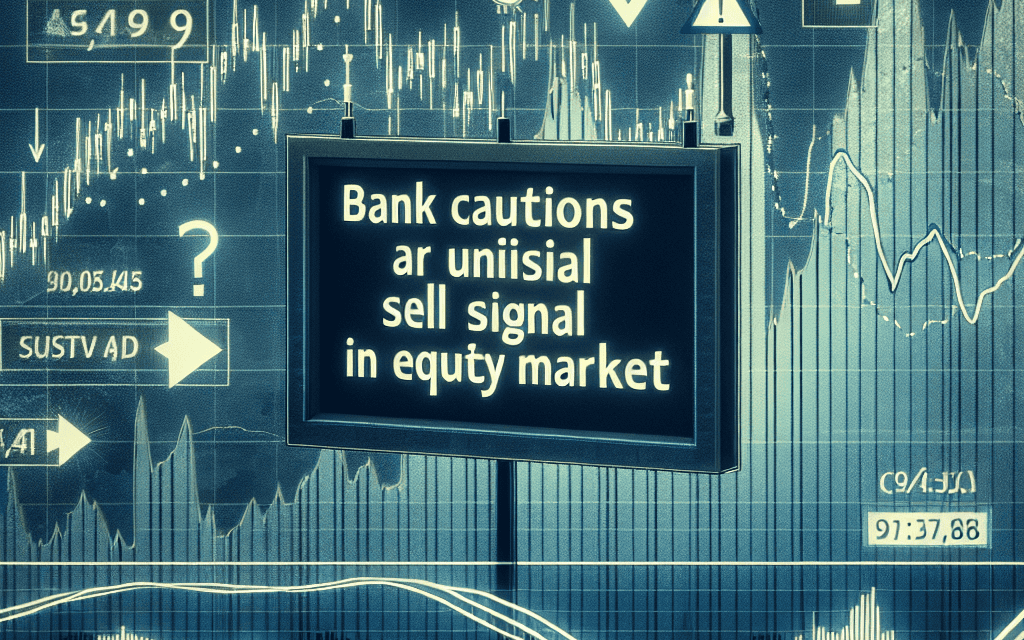“Bank of America Flags Rare Sell Signal: A Market Shift Not Seen Since February 2021”
Introduction
In a recent analysis, Bank of America has issued a cautionary note regarding a rare sell signal emerging in the stock market, a phenomenon not observed since February 2021. This warning comes amid heightened market volatility and economic uncertainty, prompting investors to reassess their strategies. The signal, which is based on specific technical indicators, suggests potential downside risks and has sparked discussions among market participants about the future trajectory of stock prices. As investors navigate these turbulent times, Bank of America’s alert serves as a critical reminder of the complexities and challenges inherent in financial markets.
Understanding The Rare Sell Signal: Insights From Bank Of America
In recent developments, Bank of America has issued a cautionary note regarding a rare sell signal in the stock market, a phenomenon not observed since February 2021. This signal, which has captured the attention of investors and analysts alike, suggests potential turbulence ahead for the financial markets. To comprehend the implications of this warning, it is essential to delve into the nature of the sell signal and the factors contributing to its emergence.
The sell signal in question is derived from a combination of technical indicators and market conditions that, when aligned, suggest a potential downturn in stock prices. Historically, such signals have been precursors to market corrections, prompting investors to reassess their portfolios and risk exposure. Bank of America’s analysis indicates that the current market environment bears similarities to previous instances where sell signals have accurately predicted declines, thus warranting a closer examination of the underlying causes.
One of the primary factors contributing to the emergence of this sell signal is the recent volatility in global markets. Economic uncertainties, geopolitical tensions, and fluctuating interest rates have collectively created an environment of instability. These elements have led to increased market speculation and, consequently, heightened sensitivity to any signs of potential downturns. As a result, investors are becoming more cautious, seeking to mitigate risks associated with sudden market shifts.
Moreover, the current economic landscape is characterized by a complex interplay of inflationary pressures and monetary policy adjustments. Central banks worldwide are grappling with the challenge of balancing inflation control with economic growth. In this context, any indication of policy tightening or unexpected economic data can trigger significant market reactions. Bank of America’s warning underscores the importance of monitoring these developments closely, as they can exacerbate market volatility and contribute to the sell signal’s validity.
In addition to macroeconomic factors, corporate earnings reports and sector-specific trends also play a crucial role in shaping market sentiment. Recent earnings seasons have revealed mixed results, with some companies exceeding expectations while others face headwinds. This divergence in performance has led to increased scrutiny of individual stocks and sectors, further influencing the overall market outlook. Investors are advised to pay attention to these dynamics, as they can provide valuable insights into potential market movements.
Furthermore, the psychological aspect of investing cannot be overlooked. Market sentiment, driven by investor perceptions and emotions, often amplifies the impact of technical signals. The fear of missing out, coupled with concerns about potential losses, can lead to abrupt shifts in investment strategies. Bank of America’s warning serves as a reminder of the importance of maintaining a disciplined approach to investing, emphasizing the need for a well-diversified portfolio and a long-term perspective.
In conclusion, the rare sell signal identified by Bank of America highlights the need for vigilance in navigating the current market environment. While the signal itself does not guarantee an imminent downturn, it serves as a valuable tool for investors to reassess their strategies and prepare for potential challenges. By understanding the factors contributing to this signal and remaining informed about market developments, investors can make more informed decisions and better position themselves to weather any forthcoming market fluctuations.
Historical Context: Stock Market Trends Since February 2021
Since February 2021, the stock market has experienced a series of fluctuations, reflecting a complex interplay of economic factors, investor sentiment, and global events. During this period, the market has been characterized by both remarkable highs and unsettling lows, driven by a combination of pandemic recovery efforts, fiscal policies, and geopolitical tensions. As we delve into the historical context of stock market trends since February 2021, it is essential to understand the underlying dynamics that have shaped investor behavior and market performance.
In the early months of 2021, the stock market was buoyed by optimism surrounding the rollout of COVID-19 vaccines and the anticipated economic recovery. Investors were hopeful that widespread vaccination would lead to a resurgence in consumer spending and business activity, propelling the market to new heights. This optimism was further fueled by substantial fiscal stimulus measures implemented by governments worldwide, aimed at supporting economic growth and mitigating the impact of the pandemic.
However, as the year progressed, the market faced several headwinds that tempered investor enthusiasm. Concerns over rising inflation began to surface, driven by supply chain disruptions and increased demand for goods and services. Central banks, particularly the Federal Reserve, were closely watched for their monetary policy responses, as investors speculated on potential interest rate hikes to curb inflationary pressures. This uncertainty contributed to increased market volatility, as investors grappled with the implications of tighter monetary policy on asset valuations.
In addition to inflationary concerns, geopolitical tensions also played a significant role in shaping market trends. The ongoing trade disputes between major economies, coupled with political instability in various regions, added another layer of complexity to the investment landscape. These factors, combined with the lingering effects of the pandemic, created an environment of heightened uncertainty, prompting investors to reassess their risk appetites and portfolio allocations.
Amidst this backdrop, Bank of America recently issued a warning of a rare sell signal in the stock market, a development not seen since February 2021. This signal, which is based on a combination of technical indicators and market sentiment analysis, suggests that the market may be poised for a correction. The warning has sparked discussions among investors and analysts, as they seek to understand the potential implications of such a signal on their investment strategies.
The issuance of a sell signal by a major financial institution like Bank of America underscores the importance of remaining vigilant in a rapidly changing market environment. While historical trends can provide valuable insights into potential future movements, it is crucial for investors to consider a wide range of factors when making investment decisions. This includes not only technical indicators but also macroeconomic data, corporate earnings reports, and geopolitical developments.
In conclusion, the stock market trends since February 2021 have been shaped by a confluence of factors, including pandemic recovery efforts, inflationary pressures, and geopolitical tensions. The recent warning from Bank of America serves as a reminder of the inherent uncertainties in the market and the need for investors to remain informed and adaptable. As we move forward, it will be essential to closely monitor these evolving dynamics and their potential impact on market performance, ensuring that investment strategies are aligned with the prevailing economic landscape.
Analyzing The Impact Of Sell Signals On Investor Behavior
In recent developments, Bank of America has issued a warning regarding a rare sell signal in the stock market, a phenomenon not observed since February 2021. This signal, which has captured the attention of investors and analysts alike, serves as a crucial indicator of potential shifts in market dynamics. Understanding the implications of such signals is essential for investors aiming to navigate the complexities of the financial markets effectively.
Sell signals are typically generated by technical indicators that suggest a potential downturn in stock prices. These signals can arise from various factors, including overbought conditions, negative divergences, or other technical patterns that suggest a reversal in market trends. The rarity of the current sell signal underscores its significance, prompting investors to reassess their strategies and consider the potential risks associated with their portfolios.
The impact of sell signals on investor behavior can be profound. Historically, such signals have often led to increased volatility as market participants react to the possibility of declining asset values. Investors, driven by a mix of caution and fear, may choose to liquidate positions to mitigate potential losses. This behavior can exacerbate market fluctuations, creating a self-fulfilling prophecy where the anticipation of a downturn contributes to its realization.
Moreover, the psychological aspect of sell signals cannot be overlooked. The fear of missing out on gains, coupled with the anxiety of potential losses, can lead to heightened emotional responses among investors. This emotional volatility can result in impulsive decision-making, where investors may either exit positions prematurely or hold onto assets longer than advisable, hoping for a market rebound. Consequently, understanding the psychological underpinnings of investor behavior in response to sell signals is crucial for developing effective investment strategies.
In addition to individual investor reactions, institutional investors and fund managers also play a significant role in shaping market responses to sell signals. These entities, often managing large portfolios, may adjust their asset allocations based on technical indicators, further influencing market trends. The actions of institutional investors can amplify the effects of sell signals, as their substantial trades can lead to significant shifts in market prices.
Despite the potential for market turbulence, it is important to recognize that sell signals do not guarantee a market downturn. They serve as indicators of potential risk, prompting investors to exercise caution and conduct thorough analyses of market conditions. Prudent investors often use sell signals as a catalyst for re-evaluating their investment strategies, ensuring that their portfolios are well-diversified and aligned with their risk tolerance levels.
Furthermore, the current economic landscape, characterized by factors such as inflationary pressures, geopolitical tensions, and evolving monetary policies, adds an additional layer of complexity to interpreting sell signals. Investors must consider these macroeconomic variables when assessing the potential impact of technical indicators on market performance.
In conclusion, the rare sell signal identified by Bank of America serves as a critical reminder of the dynamic nature of financial markets. While such signals can influence investor behavior and contribute to market volatility, they also offer an opportunity for investors to reassess their strategies and make informed decisions. By understanding the implications of sell signals and considering the broader economic context, investors can navigate the challenges of the market with greater confidence and resilience.
Bank Of America’s Market Predictions: What Investors Should Know

Bank of America has recently issued a warning to investors, highlighting a rare sell signal in the stock market that has not been observed since February 2021. This development has captured the attention of market participants, prompting a closer examination of the underlying factors contributing to this signal and its potential implications for future market movements. As investors navigate these uncertain waters, understanding the context and significance of this warning is crucial.
The sell signal identified by Bank of America is rooted in a combination of technical and fundamental indicators that suggest a potential downturn in the stock market. Historically, such signals have been precursors to market corrections, prompting investors to reassess their portfolios and risk exposure. The rarity of this signal adds an additional layer of concern, as it suggests that the market may be entering a phase of heightened volatility and uncertainty.
One of the primary factors contributing to this sell signal is the current macroeconomic environment. Inflationary pressures have been mounting, driven by supply chain disruptions, labor shortages, and rising commodity prices. These factors have led to increased costs for businesses, which are often passed on to consumers in the form of higher prices. As a result, central banks around the world, including the Federal Reserve, have been contemplating tightening monetary policy to curb inflation. The prospect of rising interest rates has historically been a catalyst for market volatility, as it increases borrowing costs for companies and consumers alike.
In addition to macroeconomic concerns, the stock market has been experiencing elevated valuations, with many stocks trading at historically high price-to-earnings ratios. This has raised questions about the sustainability of current market levels, particularly in the face of potential interest rate hikes. Investors are increasingly wary of overvalued stocks, which may be more susceptible to sharp declines in the event of a market correction.
Moreover, geopolitical tensions have added another layer of complexity to the market landscape. Ongoing conflicts and diplomatic disputes have the potential to disrupt global trade and economic growth, further exacerbating market volatility. Investors are closely monitoring these developments, as any escalation could have significant implications for global financial markets.
Despite these challenges, it is important to note that not all market participants are interpreting Bank of America’s sell signal as a definitive call to action. Some investors view it as a cautionary note, prompting them to adopt a more defensive stance while remaining engaged in the market. Diversification, risk management, and a focus on quality investments are strategies that many are employing to navigate this uncertain environment.
In conclusion, Bank of America’s warning of a rare sell signal in the stock market serves as a reminder of the complex and dynamic nature of financial markets. While the signal suggests potential challenges ahead, it also underscores the importance of staying informed and adaptable in the face of changing market conditions. Investors should carefully consider their individual risk tolerance and investment objectives, while remaining vigilant to the evolving macroeconomic and geopolitical landscape. By doing so, they can better position themselves to weather potential market turbulence and capitalize on opportunities that may arise.
The Role Of Technical Indicators In Identifying Sell Signals
In the ever-evolving landscape of financial markets, investors and analysts alike rely on a myriad of tools to guide their decision-making processes. Among these tools, technical indicators play a pivotal role in identifying potential buy or sell signals. Recently, Bank of America has issued a warning regarding a rare sell signal in the stock market, a phenomenon not observed since February 2021. This development underscores the importance of understanding technical indicators and their implications for market participants.
Technical indicators are mathematical calculations based on historical price, volume, or open interest information that traders use to forecast future price movements. These indicators are essential in identifying trends, momentum, volatility, and other critical aspects of market behavior. Among the plethora of technical indicators available, some of the most commonly used include moving averages, relative strength index (RSI), and moving average convergence divergence (MACD). Each of these indicators provides unique insights into market conditions, helping traders make informed decisions.
The recent warning from Bank of America highlights the emergence of a rare sell signal, which has not been seen since early 2021. This signal is derived from a combination of technical indicators that suggest a potential downturn in the stock market. While the specifics of the indicators used by Bank of America have not been disclosed, it is likely that they involve a confluence of factors such as overbought conditions, bearish divergence, or a breakdown in key support levels. Such signals are crucial for investors as they provide early warnings of potential market reversals, allowing them to adjust their portfolios accordingly.
Transitioning from the general role of technical indicators to the specifics of sell signals, it is important to note that these signals are not infallible. They are probabilistic in nature, meaning that while they can suggest a higher likelihood of a market downturn, they do not guarantee it. Therefore, investors must exercise caution and consider other factors, such as fundamental analysis and macroeconomic conditions, before making significant investment decisions. This holistic approach ensures that decisions are not solely based on technical signals, which can sometimes be misleading due to market noise or short-term volatility.
Moreover, the rarity of the sell signal identified by Bank of America adds an additional layer of complexity. Rare signals can often lead to heightened market anxiety, as they suggest an unusual or unexpected shift in market dynamics. However, it is essential for investors to maintain a balanced perspective, recognizing that rare does not necessarily equate to imminent. Historical data shows that markets can exhibit resilience even in the face of adverse signals, driven by factors such as strong corporate earnings, accommodative monetary policies, or geopolitical stability.
In conclusion, the warning from Bank of America serves as a timely reminder of the critical role that technical indicators play in the financial markets. While the emergence of a rare sell signal may prompt concern, it also highlights the need for a comprehensive approach to investment decision-making. By integrating technical analysis with other forms of analysis, investors can better navigate the complexities of the market, making informed decisions that align with their risk tolerance and investment objectives. As the market continues to evolve, the ability to interpret and respond to technical signals will remain an invaluable skill for market participants.
Comparing Current Market Conditions To February 2021
In recent developments, Bank of America has issued a warning regarding a rare sell signal in the stock market, a phenomenon not observed since February 2021. This alert has prompted investors and analysts to draw comparisons between the current market conditions and those prevalent in early 2021. To understand the implications of this signal, it is essential to examine the factors that characterized the market environment in February 2021 and how they relate to the present situation.
In February 2021, the stock market was experiencing a period of heightened volatility and exuberance, driven largely by retail investor activity and the proliferation of speculative trading. The rise of meme stocks, fueled by social media platforms and online forums, led to unprecedented price surges in certain equities. This speculative frenzy was accompanied by a surge in trading volumes and a significant increase in market valuations, raising concerns about the sustainability of such rapid gains.
Fast forward to the present, and the market landscape exhibits some similarities to that of early 2021. Once again, there is a notable increase in retail investor participation, with individuals seeking to capitalize on perceived opportunities in the market. This renewed interest has been partly driven by the availability of trading platforms that offer easy access to financial markets, as well as a growing appetite for risk among investors. Consequently, certain stocks have experienced sharp price movements, reminiscent of the meme stock phenomenon.
However, there are also key differences between the two periods that merit consideration. In 2021, the market was buoyed by unprecedented fiscal and monetary stimulus measures implemented in response to the COVID-19 pandemic. These measures provided significant liquidity to the financial system, supporting asset prices and encouraging risk-taking behavior. In contrast, the current environment is characterized by a gradual withdrawal of such stimulus, as central banks around the world begin to tighten monetary policy in response to rising inflationary pressures.
This shift in policy stance has introduced a new set of dynamics into the market, with investors increasingly focused on the implications of higher interest rates and reduced liquidity. As a result, there is heightened sensitivity to economic data releases and central bank communications, which can lead to increased market volatility. This backdrop has contributed to the emergence of the rare sell signal identified by Bank of America, as investors reassess their risk exposures in light of changing macroeconomic conditions.
Moreover, the geopolitical landscape has also evolved since February 2021, with ongoing tensions in various regions adding another layer of complexity to the investment environment. These geopolitical risks can have significant implications for global markets, influencing investor sentiment and potentially exacerbating market volatility.
In conclusion, while there are parallels between the current market conditions and those of February 2021, there are also important distinctions that must be acknowledged. The rare sell signal highlighted by Bank of America serves as a reminder of the need for vigilance and careful analysis in navigating the complexities of today’s financial markets. As investors grapple with the challenges posed by shifting monetary policies, geopolitical uncertainties, and evolving market dynamics, a nuanced understanding of these factors will be crucial in making informed investment decisions.
Strategies For Investors: Navigating Market Volatility And Sell Signals
In the ever-evolving landscape of financial markets, investors are constantly on the lookout for signals that might indicate shifts in market dynamics. Recently, Bank of America has issued a warning about a rare sell signal in the stock market, a phenomenon not observed since February 2021. This development has prompted investors to reassess their strategies, as navigating market volatility requires a keen understanding of both macroeconomic indicators and technical signals. As the market grapples with this new information, it is crucial for investors to adopt strategies that can help mitigate risks while capitalizing on potential opportunities.
To begin with, understanding the nature of the sell signal is essential. Sell signals are typically generated by technical indicators that suggest a potential downturn in stock prices. These signals can be triggered by various factors, including overbought conditions, negative divergences, or significant shifts in market sentiment. In this case, Bank of America’s warning highlights the importance of being vigilant and prepared for potential market corrections. While such signals do not guarantee an immediate downturn, they serve as a cautionary note for investors to review their portfolios and consider rebalancing their asset allocations.
In light of this warning, diversification emerges as a key strategy for investors. By spreading investments across different asset classes, sectors, and geographical regions, investors can reduce their exposure to any single market event. This approach not only helps in managing risk but also provides opportunities for growth in areas that may not be directly affected by the sell signal. Moreover, diversification can act as a buffer against market volatility, allowing investors to maintain a more stable portfolio during uncertain times.
Another strategy to consider is the implementation of stop-loss orders. These orders automatically sell a security when it reaches a predetermined price, thereby limiting potential losses. In a market environment where sell signals are present, stop-loss orders can serve as an effective tool to protect investments from significant downturns. However, it is important for investors to set these orders at appropriate levels, taking into account the volatility and historical price movements of the securities in question.
Furthermore, maintaining a long-term perspective is crucial when navigating market volatility. While sell signals may indicate short-term fluctuations, it is important to remember that markets have historically trended upwards over the long run. Investors who remain focused on their long-term goals and avoid making impulsive decisions based on short-term market movements are more likely to achieve favorable outcomes. This approach requires discipline and patience, as well as a thorough understanding of one’s investment objectives and risk tolerance.
In addition to these strategies, staying informed about macroeconomic developments and market trends is vital. Economic indicators such as interest rates, inflation, and employment figures can have significant impacts on market dynamics. By keeping abreast of these factors, investors can make more informed decisions and adjust their strategies accordingly. Engaging with financial advisors and leveraging research from reputable sources can also provide valuable insights and guidance during periods of market uncertainty.
In conclusion, the rare sell signal identified by Bank of America serves as a reminder of the inherent volatility in financial markets. By employing strategies such as diversification, stop-loss orders, and maintaining a long-term perspective, investors can better navigate these challenges. Staying informed and seeking professional advice further enhances one’s ability to make sound investment decisions. Ultimately, while market signals may prompt caution, they also present opportunities for those who are prepared and strategic in their approach.
Q&A
1. **What is the rare sell signal Bank of America warned about?**
The rare sell signal is the “Hindenburg Omen,” which is a technical pattern that suggests a potential stock market decline.
2. **When was the last time this sell signal was observed?**
The last time this sell signal was observed was in February 2021.
3. **What does the Hindenburg Omen indicate?**
The Hindenburg Omen indicates a heightened risk of a stock market correction or crash.
4. **What are the criteria for the Hindenburg Omen to occur?**
The criteria include a high number of new 52-week highs and lows on the NYSE, a rising 50-day moving average, and other technical conditions.
5. **How does Bank of America suggest investors respond to this signal?**
Bank of America suggests that investors should be cautious and consider risk management strategies.
6. **What impact does the Hindenburg Omen have on investor sentiment?**
The Hindenburg Omen can lead to increased investor anxiety and a more cautious approach to stock market investments.
7. **Has the Hindenburg Omen been accurate in predicting market downturns in the past?**
The Hindenburg Omen has had mixed results in the past, sometimes preceding market downturns but not always leading to significant declines.
Conclusion
Bank of America’s warning about a rare sell signal in the stock market, not seen since February 2021, suggests heightened caution among investors. This signal may indicate potential overvaluation or an impending market correction, prompting investors to reassess their portfolios and risk exposure. The warning underscores the importance of vigilance and strategic planning in navigating potential market volatility.





